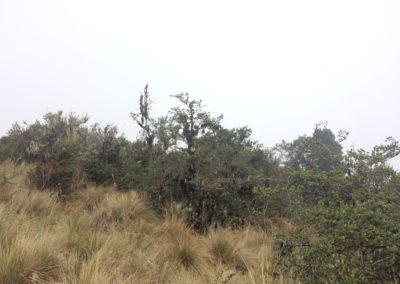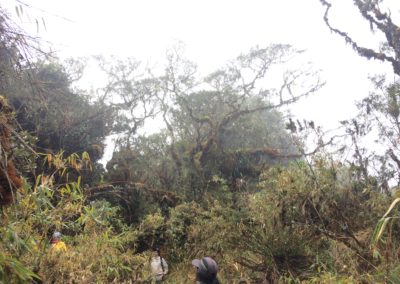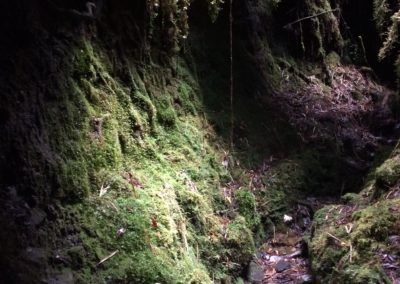
HELLO!
I am a postdoctoral research fellow at the Senckenberg Biodiversity and Climate Research Centre in Frankfurt am Main, Germany.
Together with Dr Thomas Kastner, I am working on quantifying and downscaling biodiversity targets to different sectors and actors.
In previous projects, I was studying effects of global change (climate change and species introductions) on interacting species with trait-based approaches.
Contact
E-Mail: larissanowak89@gmail.com
Current affiliation
Senckenberg Biodiversity and Climate Research Centre
Senckenberganlage 25
60325 Frankfurt am Main, Germany
RESEARCH INTEREST
My research revolves around two main topics. On the one hand, I am interested in understanding how different aspects of global change impact biodiversity. On the other hand, I aim to find ways to apply such knowledge to protect biodiversity in a changing world.
My current project focuses on making biodiversity targets measurable and downscaling them to different sectors and actors. This work is part of a bigger project aiming at contributing to halting and reversing biodiversity loss caused by global biomass production systems.
In previous projects, I applied trait-based approaches to understand the potential impacts of future climate change and species introductions on interacting species. This work focused on mutualistic interactions between fleshy-fruited plants and avian frugivores, which contribute to the ecosystem function of seed dispersal.
Keywords: ecology, global change, biodiversity, species‘ traits, biodiversity targets
PUBLICATIONS
Nowak, L., Schleuning, M., Bender, I. M. A., Böhning-Gaese, K., Dehling, D. M., Fritz, S. A., Kissling, W. D., Müller, T., Neuschulz, E. L., Pigot, A., Sorensen, M. C., Donoso, I. (2022). Avian seed dispersal may be insufficient for plants to track future temperature change on tropical mountains. Global Ecology and Biogeography, 31, 848-860.
Nowak, L., Schleuning, M., Bender, I. M. A., Kissling, W. D., Fritz, S. A. (2022). Independent variation of avian sensitivity to climate change and adaptive capacity along a tropical elevational gradient. Diversity and Distributions, 28, 1123-1135.
Bagnara, M., Nowak, L., Boehmer, J., Schöll, F., Schurr, F., Seebens, H. (2022). Simulating spread and establishment of alien species along aquatic and terrestrial transportation networks – a multi-pathway and high resolution approach. Journal of Applied Ecology, 59, 1769-1780.
Tobias, A. J., […], Nowak L., […], Fritz, S. A., Thomas G. H., Schleuning M. (2022). AVONET: morphological, ecological and geographical data for all birds. Ecology Letters, 25, 581-597.
Schleuning, M., Neuschulz, E. L., Albrecht, J., Bender, I. M., Bowler, D. E., Dehling, D. M., Fritz, S. A., Hof, C., Mueller, T., Nowak, L., Sorensen, M. C., Böhning-Gaese, K., & Kissling, W. D. (2020). Trait-based assessments of climate-change impacts on interacting Species. Trends in Ecology & Evolution, 35, 319-328.
Nowak, L., Kissling, W. D., Bender, I. M. A., Dehling, D. M., Töpfer, T., Böhning-Gaese, K., & Schleuning, M. (2019). Projecting consequences of global warming for the functional diversity of fleshy-fruited plants and frugivorous birds along a tropical elevational gradient. Diversity and Distributions, 25, 1362-1374.
Bender, I. M. A., Kissling, W. D., Böhning-Gaese, K., Hensen I., Kühn, I., Nowak, L., Töpfer, T., Wiegand, T., Dehling, D. M., & Schleuning, M. (2019). Projected impacts of climate change on functional diversity of frugivorous birds along a tropical elevational gradient. Scientific Reports, 9, 17708.
Bender, I. M. A., Kissling, W. D., Blendinger, P. G., Böhning-Gaese, K., Hensen I., Kühn, I., Muñoz, M. C., Neuschulz, E. L. , Nowak, L., Quitián, M., Saavedra, F., Santillán, V., Töpfer, T., Wiegand, T., Dehling, D. M., & Schleuning, M. (2018). Morphological trait matching shapes plant-frugivore networks across the Andes. Ecography, 41, 1910-1919.
Dugger, P. J., Blendinger, P. G., Böhning-Gaese, K., Chama, L., Correia, M., Dehling, D. M., Emer, C., Farwig, N., Fricke E. C., Galetti, M., García, D., Grass, I., Heleno, R., Jacomassa, F. A. F., Moraes, S., Moran, Catherine, Muñoz, M. C., Neuschulz, E. L., Nowak, L. , Piratelli, A., Pizo, M. A., Quitián, M., Rogers, H. S., Ruggera, R. A., Saavedra, F., Sánchez, M. S., Sánchez, R., Santillán, V., Schabo, D. G., Ribeiro da Silva, F., Timóteo, S., Traveset, A., Vollstädt, M. G. R., & Schleuning, M. (2018). Seed-dispersal networks are more specialized in the Neotropics than in the Afrotropics. Global Ecology and Biogeography, 28, 248-261.
CV
Education
Ph.D. in Ecology. Senckenberg Biodiversity and Climate Research Centre and Goethe University Frankfurt, 07/2021
M.Sc. in Ecology and Evolution. Goethe University Frankfurt, 02/2016
B.Sc. in Environmental Science and International Forestry. Albert-Ludwig University, Freiburg, 02/2013
Scientific positions and scholarships
Postdoctoral research fellow in ‚Coproduced transformative knowledge to accelerate change for biodiversity (RAINFOREST)‘ at Senckenberg Biodiversity and Climate Research Centre, since 01/2023
Postdoctoral reserach fellow and Alexander von Humboldt foundation scholar, Mediterranean Institute for Advanced Studies (IMEDEA), 01/2022 – 12/2022
Research fellow in ‚Modelling species introductions’, Senckenberg Biodiversity and Climate Research Centre, 02/2021 – 10/2021
Doctoral research fellow in Emmy Noether Programme, ‘Macroevolution of climatic niches in birds’, Senckenberg Biodiversity and Climate Research Centre, 11/2020 – 01/2021
Doctoral research fellow in ‘Impacts of climate change on interacting plant and bird species’, Senckenberg Biodiversity and Climate Research Centre, 10/2016 – 10/2020
Research assistance at Senckenberg Biodiversity and Climate Research Centre, Frankfurt am Main, Germany, 12/2015 – 09/2016
Additional experience
Teaching in the seminar ‚Sozial-ökologische Problemanalyse und
Gestaltungsoptionen an Fallbeispielen‚ Biodiversität, Klimawandel und
nachhaltige Entwicklung‘ (social-ecological problem analysis), Goethe
University and Institute for Social-ecological Research, Frankfurt am Main,
Germany, since 2023
Teaching assistance in Master course ‘Community Ecology, Movement Ecology and Macroecology’ at Senckenberg Biodiversity and Climate Research Centre and Goethe University, Frankfurt am Main, Germany, 2016 – 2021
Internship at Forstliche Versuchs- und Forschungsanstalt Baden-Württemberg (forestry research institute), section forest ecology, Freiburg, Germany, 2012
BLOG
Biodiversity – the fascinating variety of life on Earth (March 2022)
The diversity of life on Earth is striking. To date, we know of more than 6000 mammal species, about 10,000 bird species, almost 400,000 plant species, and approximately 1,000,000 insect species. But this is not all. It is estimated that many species are not even discovered yet, e.g., about 80% of the global insect species are still to be described.
This wide variety of life on Earth is termed biodiversity.
Biodiversity not only refers to the diversity of plants, animals or fungi dwelling on Earth, but it also encompasses as tiny things as single genes and as big things as entire ecosystems. Biodiversity enriches the planet with various colours, shapes, smells, and sounds, and it is everywhere around us. The forest where we go for a walk, the lake where we swim or the garden next to our house are full of buzzing life. Even in the middle of a city, we will encounter biodiversity. Be it the plant that squeezes its way through the asphalt, the bird that sings in an ornamental tree, or the bat that circles a street lamp at night, we can find different forms of life everywhere.
And why should we care about biodiversity? – You may wonder. Indeed, there are several important reasons, but for now, I would like to introduce one of my favourite reasons: biodiversity brings joy. It is joyful, fascinating, and inspiring to discover what is flying, crawling, hopping, twittering, or growing around us with all our senses.
How about taking on a challenge? Next time you step out of your door, go to your balcony or open a window, pause a minute and discover the different forms of life surrounding you. Which plants can you see, from tiny to large? Which animals can you hear? Are there any nature-related smells, for example, of flowers or herbs? Which colours and shapes do you see? Can you count the living beings around you? I bet the longer you look, the more you will discover. Give it a try.
References
1. Burgin, C. J., Colella, J. P., Kahn, P. L. & Upham, N. S. How many species of mammals are there? J. Mammal. 99, 1–14 (2018).
2. HBW & BirdLife. HBW and BirdLife Taxonomic Checklist v6. http://datazone.birdlife.org/species/taxonomy.
3. Barrowclough, G. F., Cracraft, J., Klicka, J. & Zink, R. M. How Many Kinds of Birds Are There and Why Does It Matter? PLoS One 11, e0166307 (2016).
4. Christenhusz, M. J. M. & Byng, J. W. The number of known plants species in the world and its annual increase. Phytotaxa 261, 201 (2016).
5. Stork, N. E. How many species of insects and other terrestrial arthropods are there on Earth? Annu. Rev. Entomol. 63, 31–45 (2018).
6. Mora, C., Tittensor, D. P., Adl, S., Simpson, A. G. B. & Worm, B. How many species are there on Earth and in the ocean? PLoS Biol. 9, e1001127 (2011).
7. CBD. Convention on Biological Diversity – Article 2. Use of terms.
8. Díaz, S. et al. Assessing nature’s contributions to people. Science 359, 270–272 (2018).
A walk on Palma’s city wall on a summer evening (May 2022)
I have taken on the challenge of my previous post and went out to discover what forms of biodiversity I would encounter when walking on the city wall of Palma de Mallorca. It is summer, it is warm and humid, and I am usually taking my walks in the evening. While doing these walks, I realized that two species groups are very easy to spot.
The first and probably most apparent are plants. On the one hand, ornamental plants have been planted along the way, such as the Ombú – or Elephant tree (Phytolacca dioica). This tree species originates from South America and impresses with a huge trunk and a large crown that gives valuable shade during this time of the year. On the other hand, several plants have not been planted but grow randomly on the stonewalls, to which the wind or animals have likely dispersed them. Those plants are my favourites because they give the whole place a slightly wild atmosphere. Among them are the caper bush (Capparis spinosa), well-known for its edible flower buds but also having lovely flowers. This species is native to the Mediterranean region and is well adapted to high radiation, high temperatures and dry soils. Another example is the common lantana (Lantana camara), a plant with pretty, colourful little flowers. This species originates from Central and South America but has been introduced to many countries worldwide and is considered invasive, meaning it can have negative consequences for the ecosystems it has been brought to by humans.
The second group are birds. As the city wall is very close to the sea, seagulls can be spotted flying by, and their screams can be heard quite far. Among the seagulls on Mallorca are the yellow-legged gull (Larus michahellis), a large omnivorous species with a characteristic yellow beak and yellow legs, and the Audouin’s gull (Ichthyaetus audouinii), a beautiful red-beaked species specialized on feeding on fish. Other smaller bird species can also be observed, for example, the common blackbird (Turdus merula), a mid-sized, black, yellow-beaked species that is likely familiar to many of you as it is widespread and occurs close to human settlements.
Of course, plants and birds are not the only species found around Palma’s city wall. When my walks take longer and the sun starts to set, I sometimes see bats flying and once, I was also able to spot a lizard darting up the wall. How about you? Which forms of biodiversity did you meet during your last walk?
My first encounter with an Octopus (July 2022)
A few days ago, I went to the coast in the South-East of Mallorca to spend a day at the sea, sunbathing and snorkelling. Snorkelling around Mallorca is fantastic. The water is usually crystal clear, and one can easily see down to the ground. We went to a rocky spot with meadows of Posidonia (Posidonia oceanica), a seagrass endemic to the Mediterranean sea, an important breeding ground and home to various marine animals.
When snorkelling, I saw a beautiful underwater landscape of varying depths, a mix of seagrass and rocky ground. There were numerous fishes, some swimming very close to me, and when I moved slowly and carefully, they were pretty relaxed and unafraid. Among them were saddled seabreams (Oblada melanura) with a characteristic dark spot at the base of their caudal fin. I also saw groups of tiny blue fishes closer to the ground and larger swarms of small, greenish, shining fishes that showed impressive swarm behaviour, such as changing directions almost simultaneously.
However, the highlight of that day was an encounter with an octopus (Octopus vulgaris). It was the first time I saw one in the wild (not on a screen). At first, I did not recognize it because it was sitting on the ground, well hidden, its colours adapted to the surroundings. I swam over it and thought, “that piece of rock has a bit of a strange shape…”. So I swam back, floated over the spot and paid closer attention. The octopus seemed a bit softer and more round than its surroundings. I could see some differently coloured skin, and then I spotted the eyes—what a beautiful moment and what an impressive animal. I was excited.
Later, I did some reading on octopuses. They are fascinating in many ways—for example, their ability to camouflage. With the help of specialized muscles and pigment cells in their skin, they can match their surroundings‘ colours, patterns and textures within seconds. As means of protection, they can squirt ink to distract potential predators. They have not one but three hearts, blue blood, and in addition to their central brain, a mini-brain in each of their tentacles. How amazing is this? An impressive example for how the fascinating variety of life on Earth can play out.
Indigenous subsistence agriculture and traditional agricultural practices in Oaxaca, Mexico (November 2024)
Agriculture is a significant driver of the current global biodiversity loss. By expanding into natural ecosystems and intensification, which often involves high inputs of agrochemicals and a simplified, homogenised landscape, global agricultural systems contribute to reducing the quantity and quality of habitat available to species. At the same time, agriculture is crucial for global food security. As a consequence, much research is being done on how to transform agricultural systems to become more sustainable.
During a recent trip to Oaxaca, Mexico, for a conference on sustainable land use, I had the valuable opportunity to visit a small indigenous village at ca. 2500 m a.s.l. in Sierra Norte de Oaxaca. There, I was shown the small-scale, extensive agriculture of one family that cultivates a small patch of land close to their house in the forest. Their agricultural practices led to a small piece of land with a very rich and diverse structure, not comparable to the large, often simplified agricultural fields I know from Europe. Among others, they planted local varieties of maize, different species of legumes, agaves, herbs, pumpkins and fruit trees in small mixed fields. To keep the soil moist, they kept piles of cuttings from trees and shrubs on the ground, for example, near the roots of fruit trees. Furthermore, in one of their little fields, they simultaneously planted a mix of maize, legumes and pumpkins, so that the legumes fixate the nitrogen that the maize needs, while the leaves of the pumpkin plants protect the soil from drying out. Their fields are cultivated by hand and with the help of bulls, and they mostly produce crops to feed their own family and the community rather than for commercial purposes.
This was a very inspiring experience that made me wonder to what extent such small-scale, extensive, subsistence (i.e., maintaining oneself at a minimal level) agricultural practices, leading to a landscape rich in structure, could be part of the solution to make global agriculture more sustainable while feeding a growing population. Would we be able to supply sufficient food by expanding such localised, low-intensity approaches to other regions of the world? Or would such an approach take up too much space, not leaving enough room for nature (the land sharing vs. land sparing debate)? Definitely, a topic to dive deeper into.
References
1. Díaz, S. et al. (2019). Pervasive human-driven decline of life on Earth points to the need for transformative change. Science, 366(6471), eaax3100. https://doi.org/10.1126/science.aax3100
2. Winkler, K., Fuchs, R., Rounsevell, M., & Herold, M. (2021). Global land use changes are four times greater than previously estimated. Nature Communications, 12(1), 2501. https://doi.org/10.1038/s41467-021-22702-2
3. Fischer, J., Abson, D.J., Butsic, V., Chappell, M.J., Ekroos, J., Hanspach, J., Kuemmerle, T., Smith, H.G. and von Wehrden, H., 2014. Land sparing versus land sharing: moving forward. Conservation Letters, 7(3), 149-157. https://doi.org/10.1111/conl.12084

















